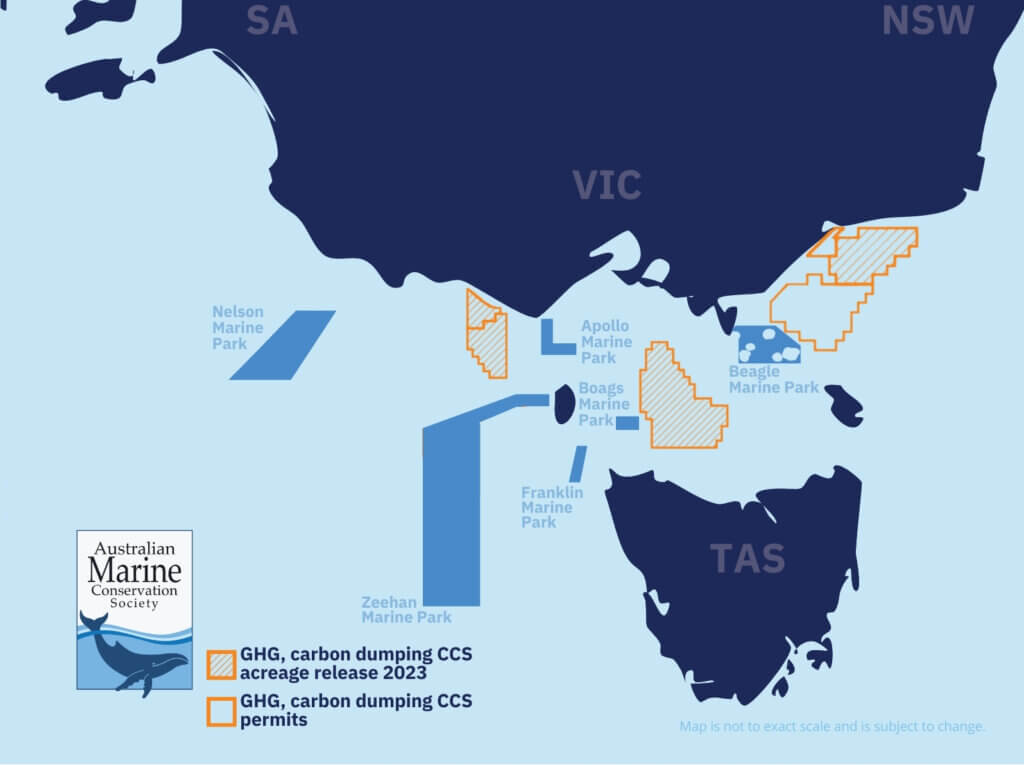Carbon Capture and Storage, commonly referred to as CCS, is a failed, expensive and dangerous technology championed by the fossil fuel industry.
Download our flyer Carbon capture and storage: A dangerous distraction (2024)
Carbon pollution dumping through carbon capture and storage (CCS) is a technique invented by the fossil fuel industry to prolong the life of old oil and gas wells. As the climate crisis unfolds, CCS is being promoted as a way to sequester carbon dioxide pollution by pumping it through depleted wells under the ground, including below the ocean floor.
Oil and gas companies use CCS as an offset for the carbon emissions of their extraction projects. This allows the industry to claim carbon neutral and net zero ambitions, while continuing to extract and burn fossil fuels—worsening the climate crisis and delaying the desperately needed shift to renewable energy.
On 23 July 2024, the Albanese government announced 10 new exploration permits for CSS in our ocean. This includes a number in the Bass Strait including for Esso/ExxonMobil off the Gippsland coast in Victoria and areas for CCS exploration in the Otway Basin overlapping areas of current seismic blasting proposals.

Areas of Bass Strait announced in July 2024 for carbon dumping CCS exploration.
Carbon pollution dumping CCS projects have alarming impacts on our marine environment and wildlife. The first stages include seismic blasting to map the structures under the seafloor. After carbon pollution is pumped under the seafloor, seismic blasting is then required every other year to monitor the area for leaks, fissures and fractures. Seismic blasting is lethal to krill, a type of zooplankton that is the foundation of our marine ecosystems. The blasts are louder than an atomic bomb and cause hearing loss in whales, disrupting their important feeding, breeding and migration behaviours.
There are risks of leaks and pollution occurring at every stage of CCS development and operation. Every year, Chevron’s Gorgon CCS project in Western Australia leaks millions of tonnes of greenhouse gas pollution that it committed to sequestering below the ocean floor. Leaks can have adverse impacts on marine plants and animals, acidifying the seawater and asphyxiating nearby marine life.
Using aging oil and gas infrastructure to transport and store carbon pollution is fraught with dangers. Carbon dioxide forms carbonic acid with any exposure to water, which is strongly corrosive to carbon steel. It is also very difficult to repurpose a pipeline designed to carry fossil gas to carry carbon pollution. In the US, several major leaks have occurred from ExxonMobil’s carbon dioxide transport pipelines, with serious health implications for nearby communities.
In recent years, the Australian Government has offered up vast areas under our ocean to fossil fuel companies for carbon pollution dumping with CCS through an annual process known as ‘acreage release’. The areas proposed for CCS include huge areas off the coasts of Western Australia and the Northern Territory, and between Victoria and Tasmania.
The Australian Government must protect our oceans, marine life and climate by ending acreage release for these dangerous CCS projects and not approve any carbon pollution dumping proposals in our ocean.
AMCS, in partnership with the Environmental Defenders Office, provided this submission to the federal government’s proposal to release large areas of our oceans to potential CCS projects:
Header image: An oil platform and carbon storage project in the South China Sea. Photo by Mao Siqian/Xinhua via Getty Images.